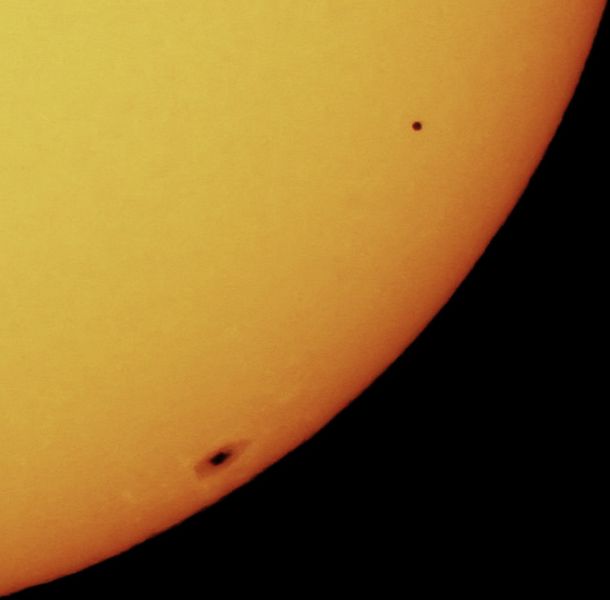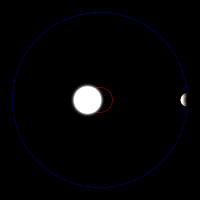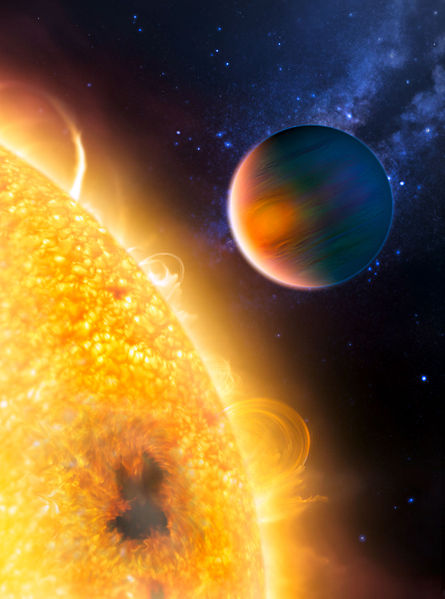Winks, Wobbles and Blips - Finding Exoplanets
Interview with
Carole - What we're doing is presenting the methods that are used to find planets around other stars. Obviously we're very familiar with the planets in our own solar system. We've known about those for a long time. We can see them quite easily because they're bathed in light from the sun. To see a planet around another star is much more difficult because the star itself is very bright so we can't see the planets around another star directly just as we can't see the planets in our own solar system when it's daytime, when the sun is up.
 Meera - What are the techniques?
Meera - What are the techniques?
Carole - There's three techniques and we've actually given them nicknames. The three nicknames are wobbles, winks and blips.
Meera - Okay..
Carole - So probably the simplest way to understand is the winks method. That works if the planet around another star is lined up so it actually happens to pass in front of the star from our line of sight on the Earth. We see this phenomenon in our own solar system. If Mercury passes between us and the sun we observe a transit. There was a transit of Mercury recently: just a few years ago. Exo-planets too can transit. When that happens the planet is opaque so it blocks some of the light the star's emitting. An astronomer looking at that star will see it appear to get dimmer by a per cent or so. The transit will last typically for about 3 or 4 hours. What we do is we actually look at as many of the stars in the sky as we can and we measure their brightness roughly every ten minutes. We do that for the whole of the time that the star is visible in the sky so for a month every night that it's clear.
Meera - That's a lot of measurement.
Carole - It's a huge amount of measurement. A lot of the challenge in the project has not been the principle of it. It's quite easy to detect the one per cent dip in the brightness of a star but it's in the managing of huge amount of data to find the needle in the haystack, the few stars where there is a planet that is suitably aligned to execute a transit.
Meera - What's the wobbles technique?
Carole - The wobbles technique has actually been historically the most successful way of finding planets around other stars. The way it works is if you've got a star and a planet, you think about the planet orbiting the star but in fact it's a little bit more subtle than that because the planet has mass and the star has mass. Both the star and the planet are orbiting around their common centre of mass. The way to understand what the centre of mass is to think of a see saw. In order to make the see saw work you need to balance the people on the two ends of the see saw. If you now imagine a sumo wrestler and a small child on a see saw ...
Meera - Not quite balanced!
 Carole - Not quite balanced and in order to balance it you would have to move the sumo wrestler very close to the pivot point of the see saw. If you did that you would find a balance point with the sumo wrestler sitting practically on top of the pivot and the small child at a large distance from the pivot. The pivot is actually the centre of mass of the sumo wrestler and the child. The planet and the star are very similar. The planet has much less mass than the star so the pivot point or the centre of mass is very, very close to the star. The planet has a large orbit which is why we think of the planet orbiting around the star but nonetheless the star has a small orbit. It's moving too around the common centre of mass just as the sumo wrestler on the see saw is moving slightly up and down. Astronomers can see stars and they can measure their motion. They can measure it by something that's called the Doppler effect which is an effect when something is moving towards you, if it's emitting waves as it moves towards you, the waves get squashed up. As it's moving away from you the waves get stretched out. With light this has the effect of changing the colour of the light. As the star is executing its small orbit like the sumo wrestler some of the time it's moving towards you and light is red-shifted. Some of the time it's moving away from you and the light is blue-shifted.
Carole - Not quite balanced and in order to balance it you would have to move the sumo wrestler very close to the pivot point of the see saw. If you did that you would find a balance point with the sumo wrestler sitting practically on top of the pivot and the small child at a large distance from the pivot. The pivot is actually the centre of mass of the sumo wrestler and the child. The planet and the star are very similar. The planet has much less mass than the star so the pivot point or the centre of mass is very, very close to the star. The planet has a large orbit which is why we think of the planet orbiting around the star but nonetheless the star has a small orbit. It's moving too around the common centre of mass just as the sumo wrestler on the see saw is moving slightly up and down. Astronomers can see stars and they can measure their motion. They can measure it by something that's called the Doppler effect which is an effect when something is moving towards you, if it's emitting waves as it moves towards you, the waves get squashed up. As it's moving away from you the waves get stretched out. With light this has the effect of changing the colour of the light. As the star is executing its small orbit like the sumo wrestler some of the time it's moving towards you and light is red-shifted. Some of the time it's moving away from you and the light is blue-shifted.
By studying that shift astronomers can see how big a circle it is that the star is moving around in its orbit. That then allows you to work out the mass of the planet that it's in orbit with just as if you looked at your see saw and measured the distance of the sumo wrestler from the pivot and measured the distance of the small child from the pivot. That would allow you to work out their relative masses.
The wobbles method allows you to detect a planet and to measure its mass. If you detect a planet that executes a wink you know not only the radius of the planet but you know the orientation of the orbit. If you then measure the Doppler shift and apply the wobbles method you then can know the mass of that planet exactly as well as knowing its radius. If you know the mass and radius you can measure the density. If you know the density that gives you a good idea of what the planet is made of.
 Meera - That's a great amount of information to be able to deduct.
Meera - That's a great amount of information to be able to deduct.
Carole - It is, considering you can't see the planet at all. For me that's what science is all about: applying the ingenuity of human thought to solving problems and learning things, learning as much as you can.
Meera - What is the third and final method?
Carole - The third and final method is the method of gravitational microlensing. We've given it the nickname blips. This method depends on the fact that mass curves space. This was something that was discovered by Einstein when he developed his theory of general relativity. All of the stars in our galaxy are actually moving. They're moving roughly in orbit around the centre of the galaxy. They're not orbiting in a very organised way so that means from our perspective a distant star and a less distant star will sometimes happen to line up exactly. When that occurs the light from the more distant star is actually travelling through the space that's been curved by the mass of the foreground star. The curved space acts like a lens on the background star's light. This gravitational lensing effect magnifies the light from the background star and makes it appear brighter. It takes about a month for the two stars to come into alignment and then drift out of alignment again. During the course of that month if you were watching that bit of sky you would see the star appear to get steeply brighter, reaching a peak which is exact, or as exact as it's going to get, and then it declines again as they drift out of alignment.
Meera - How does this enable you to see the planets going around these stars?
Carole - If the foreground star, the one that's acting as a lens, has a planet and one of the images - the background star that's being lensed by the curved space - passes close to the planet then the planet too has mass so the planet too curves space and adds its own, smaller lensing effect. Then you'd see an additional little sharp blip that actually brightens very dramatically and then returns back down to the smoother curve over the timescale of about a day. When you see that very characteristic blip you know that there must be a planet around the foreground lensing star and from various characteristics how bright it is, how quick it is. You can work out properties such as the mass of the planet and how far it is from its host star.
Meera - How many planets using all of these methods have you managed to find so far?
Carole - So far in total we know of about 300 planets around other stars. They're being found at a tremendous rate. We really are beginning to find these planets quite quickly because the methods are now all tried and tested. Groups of astronomers are organised to implement them efficiently.










Comments
Add a comment